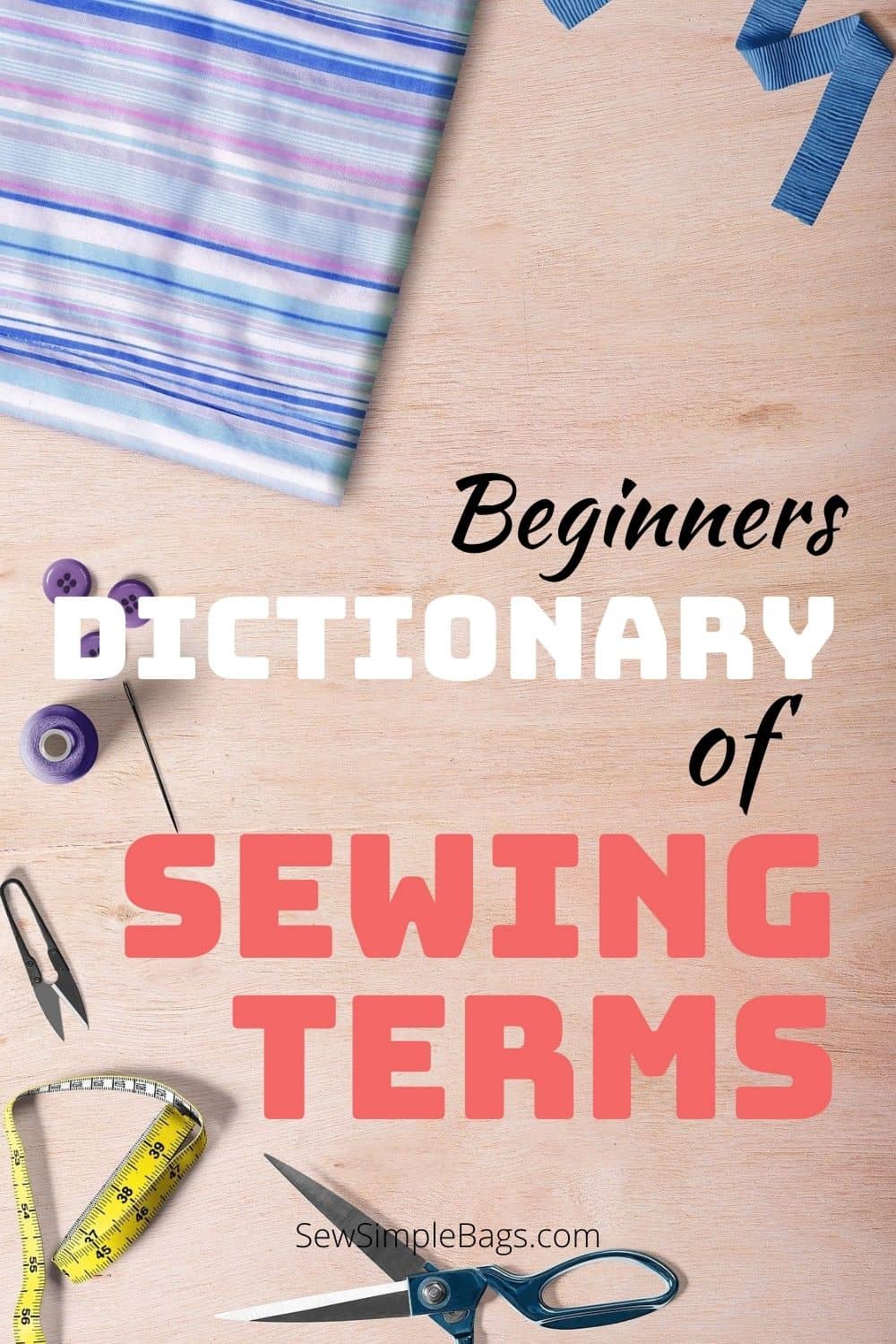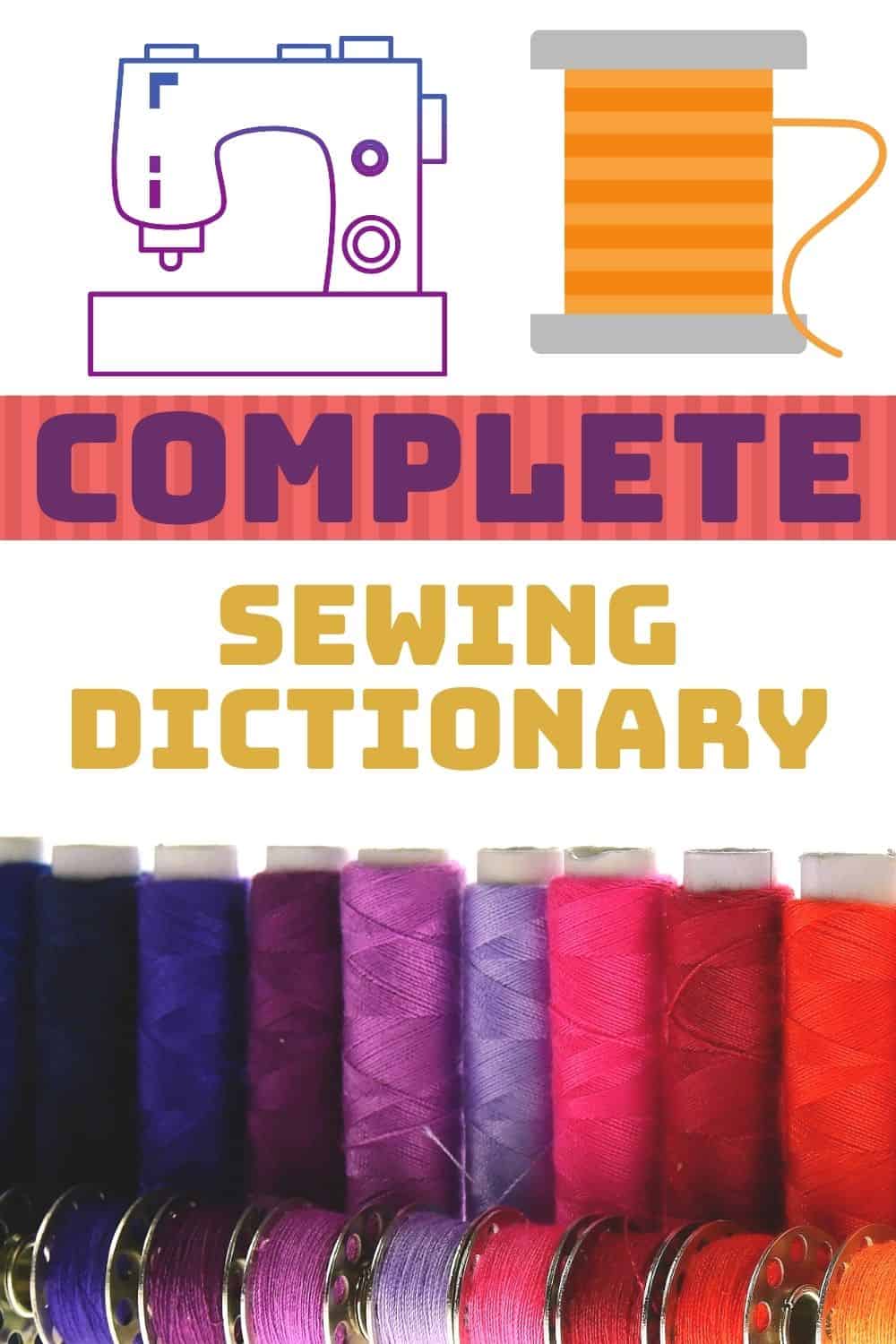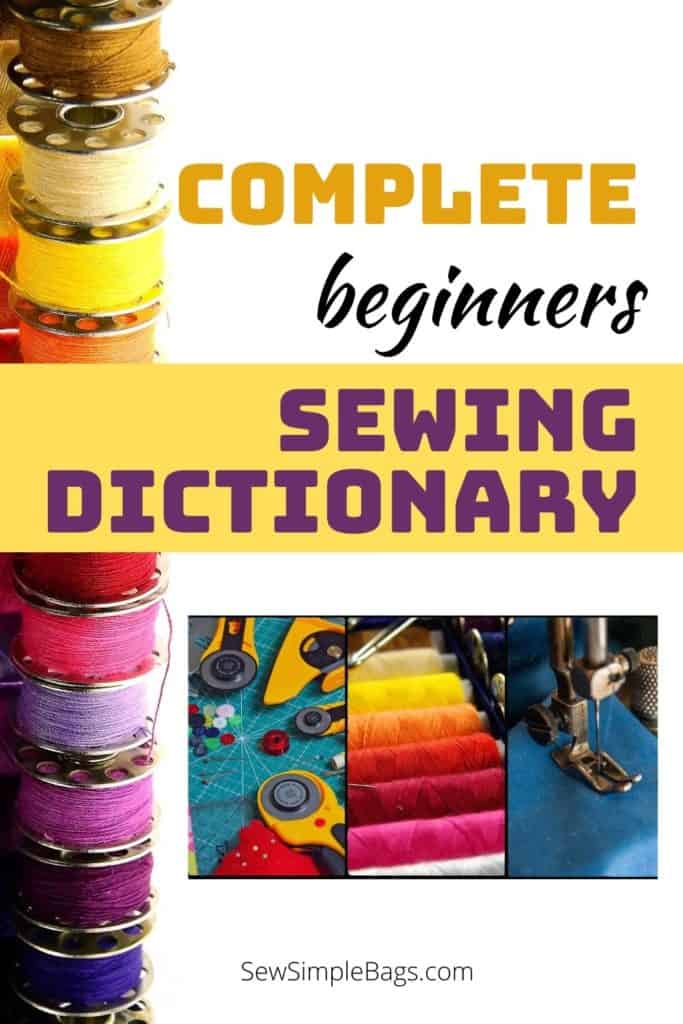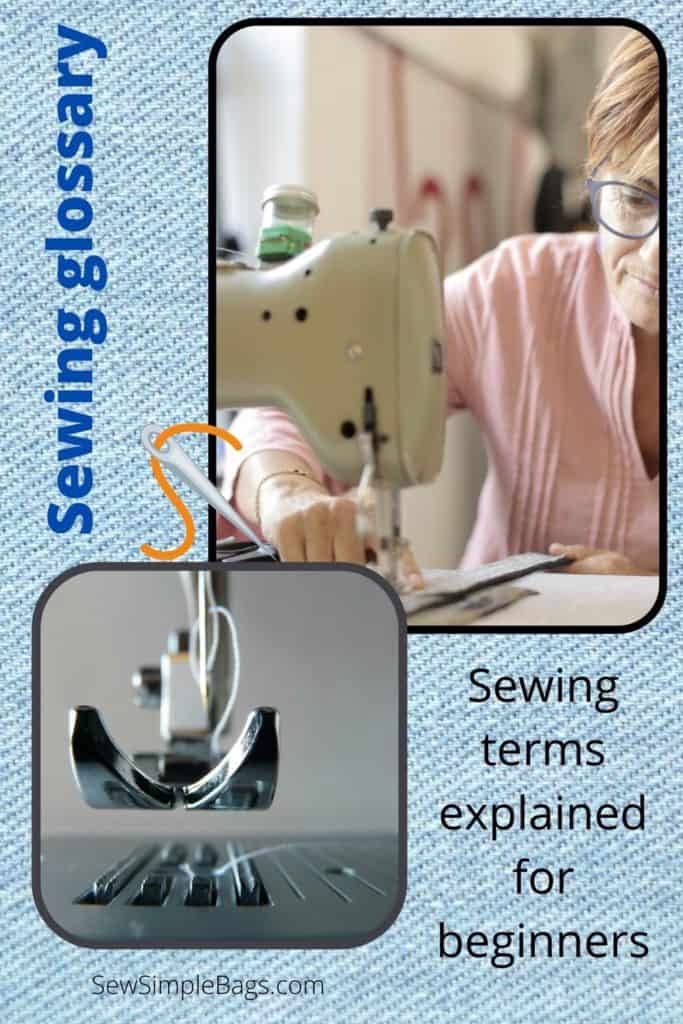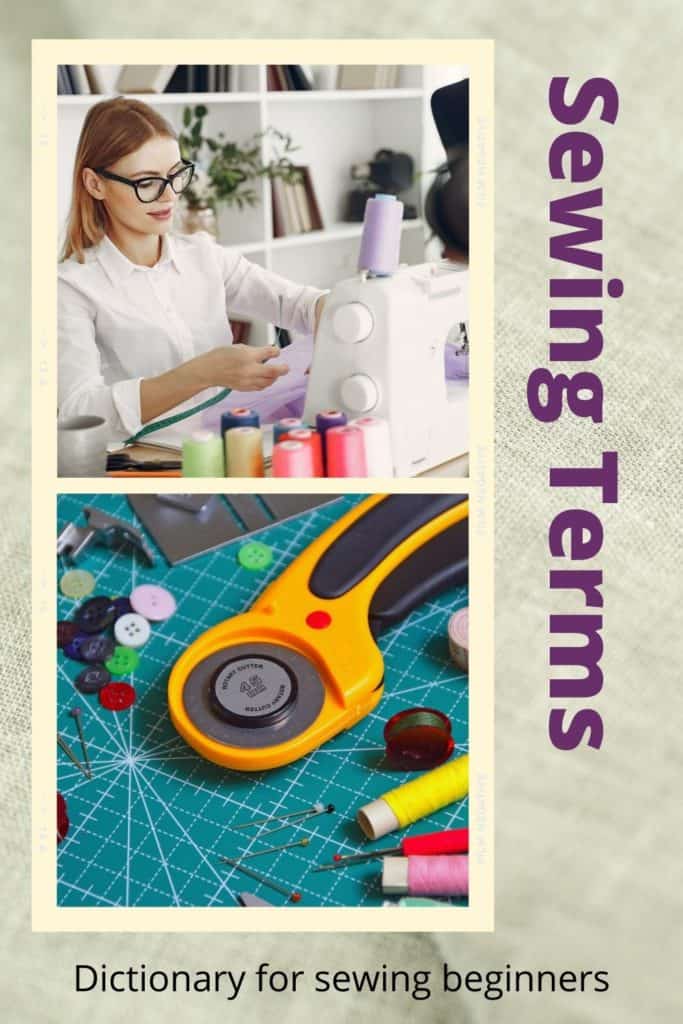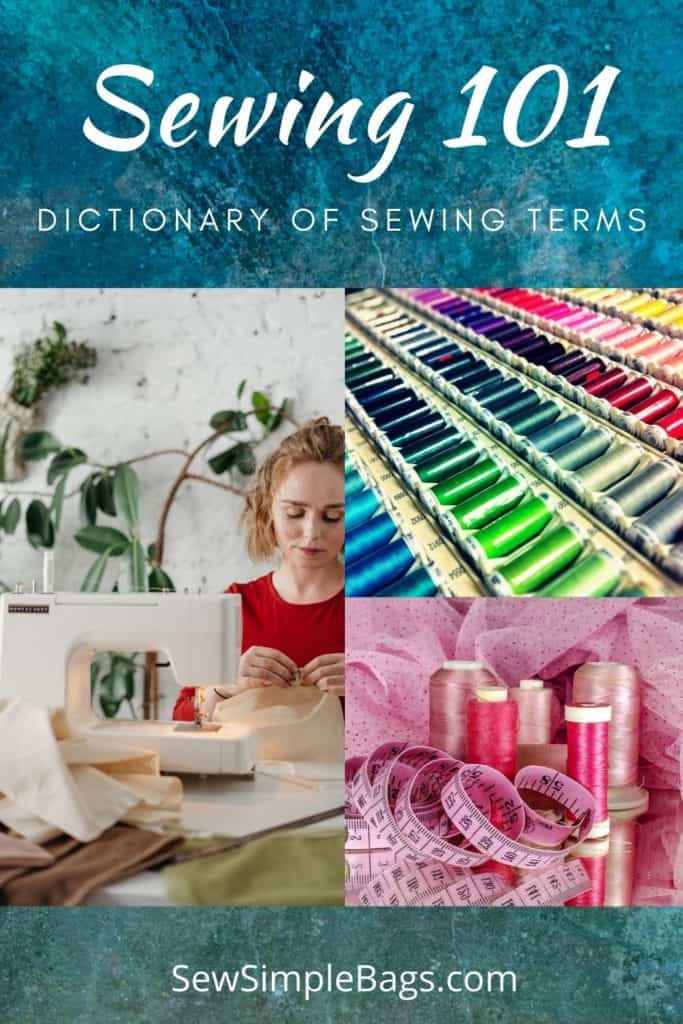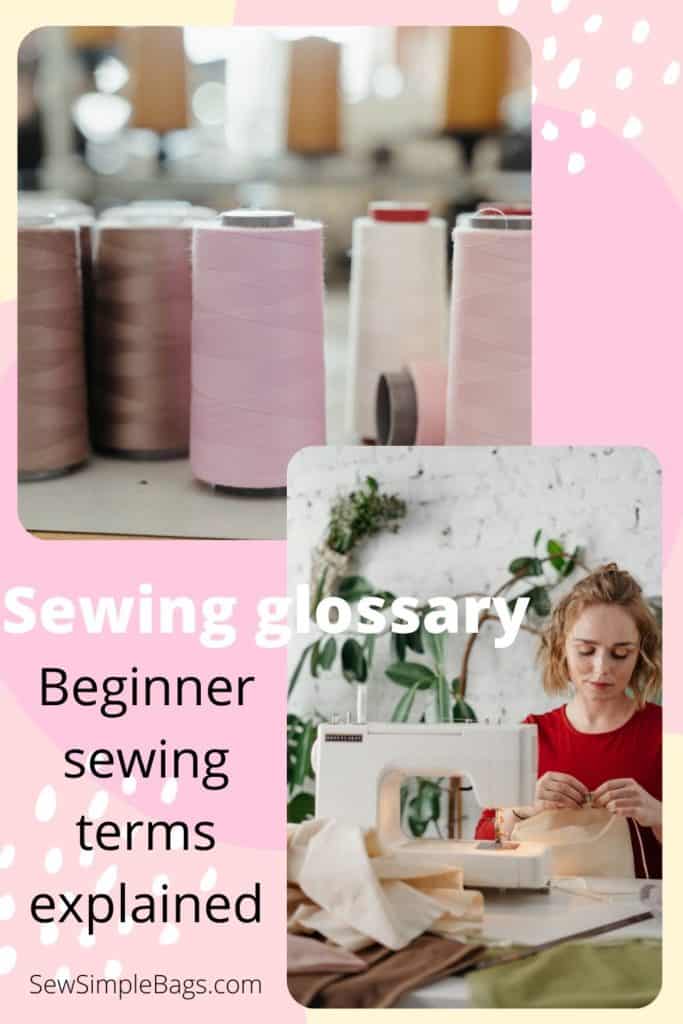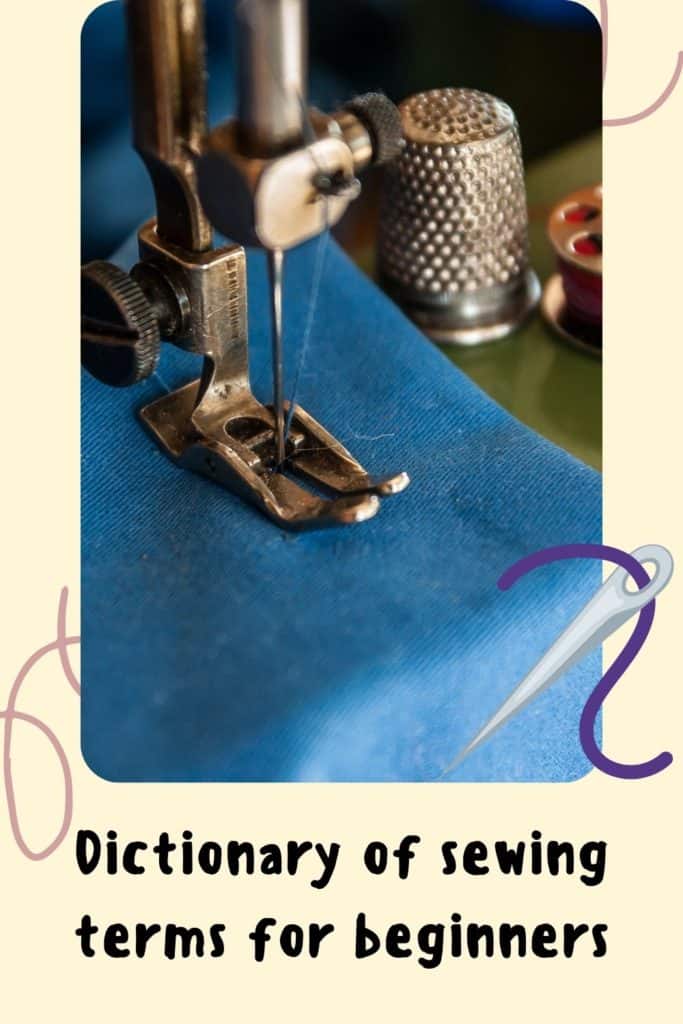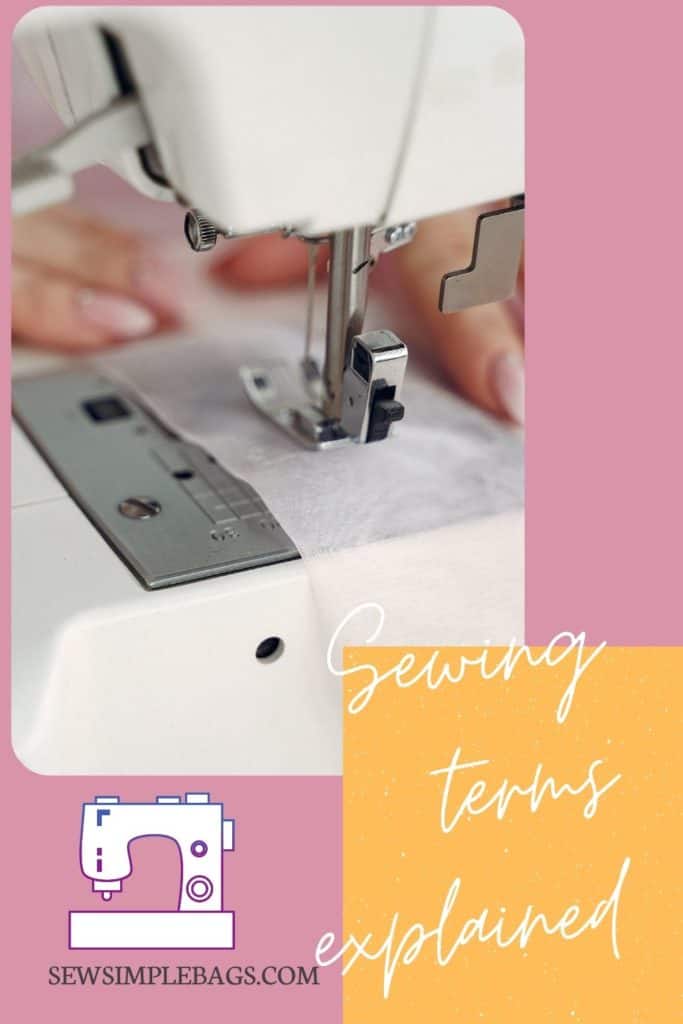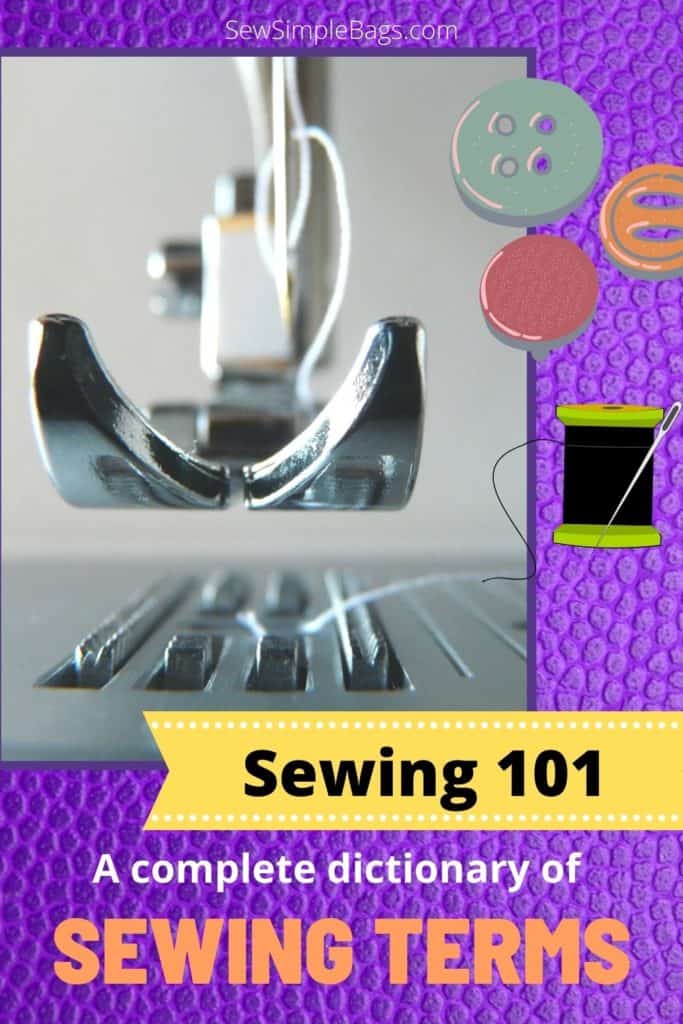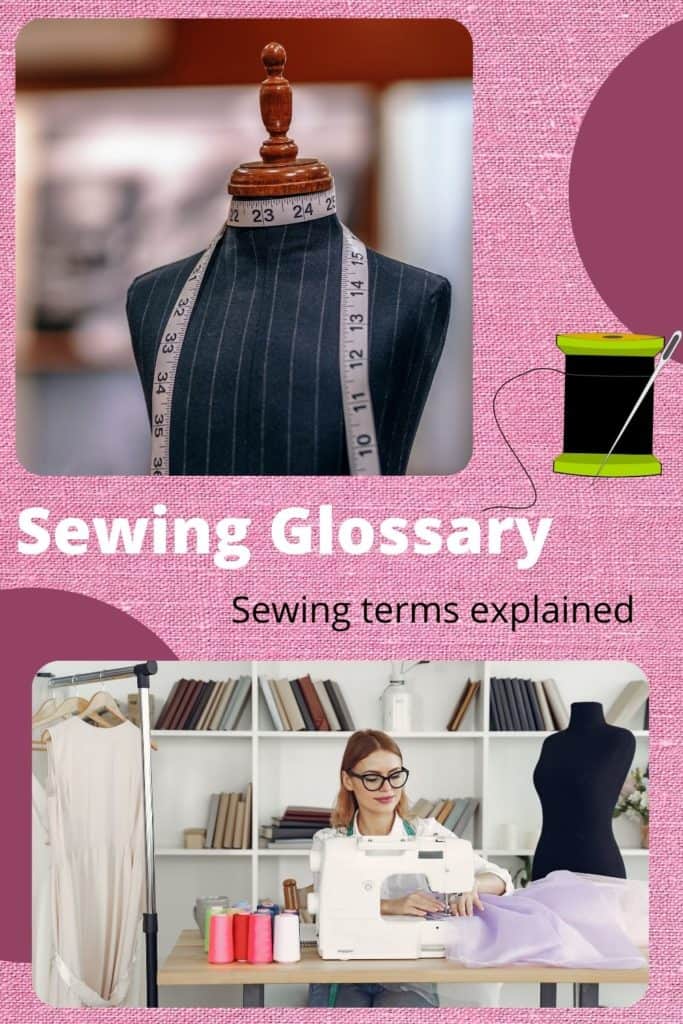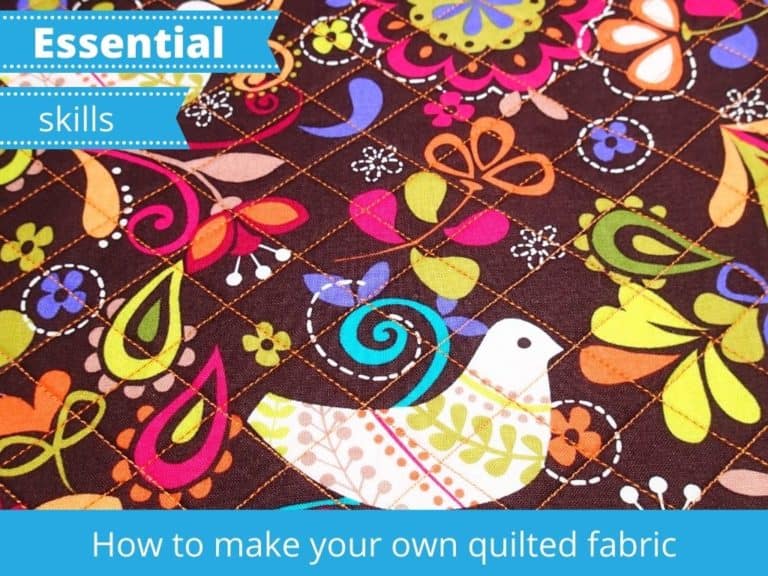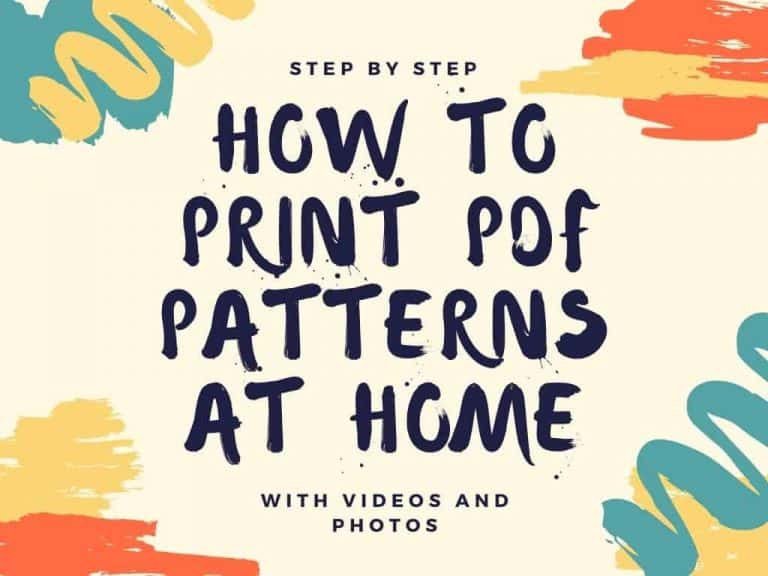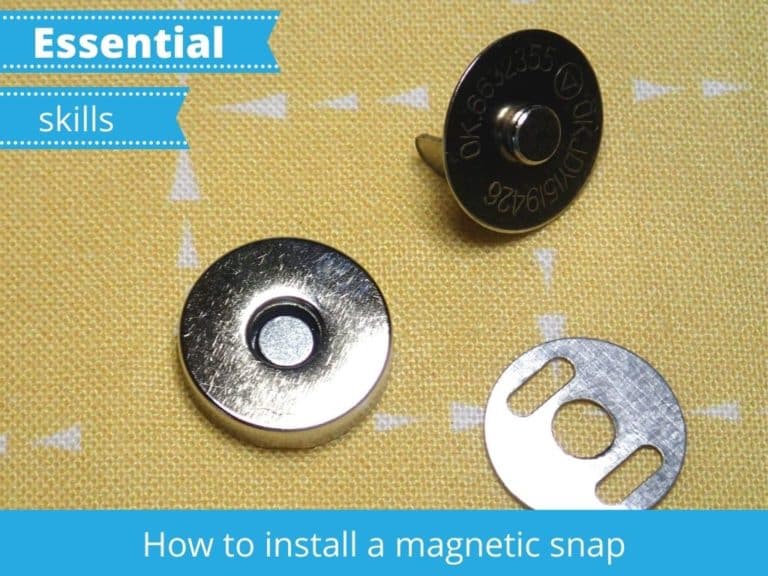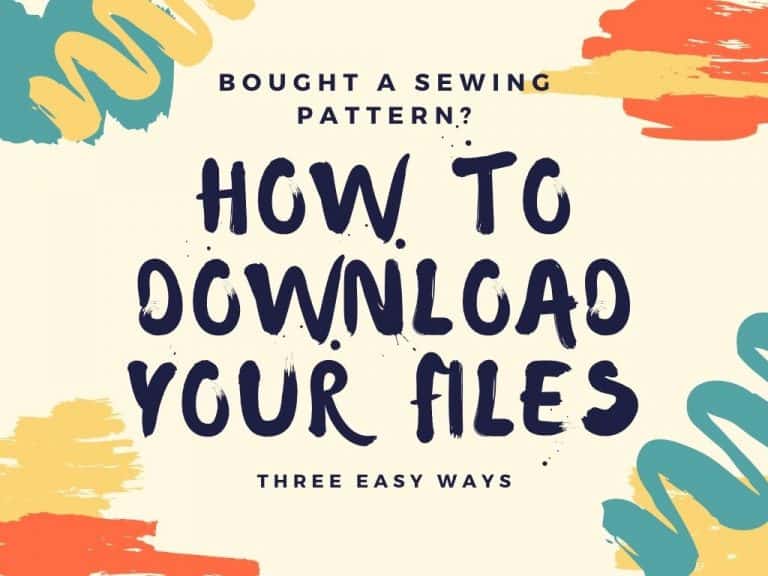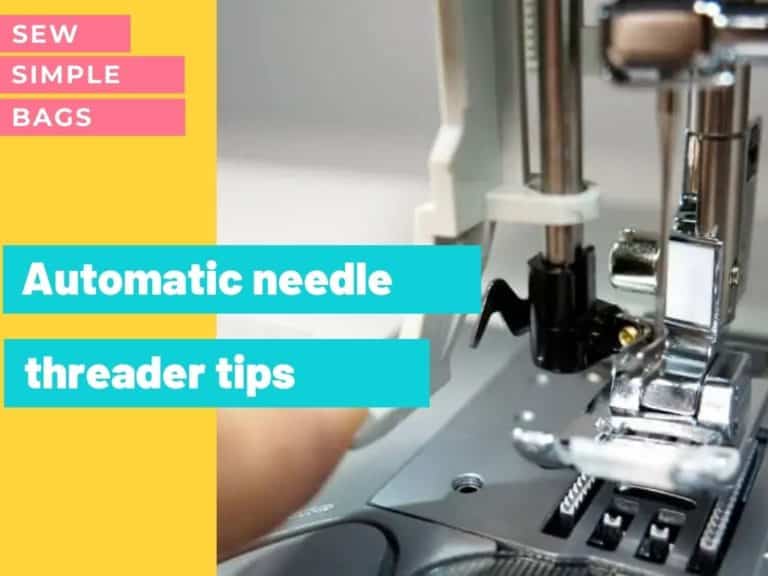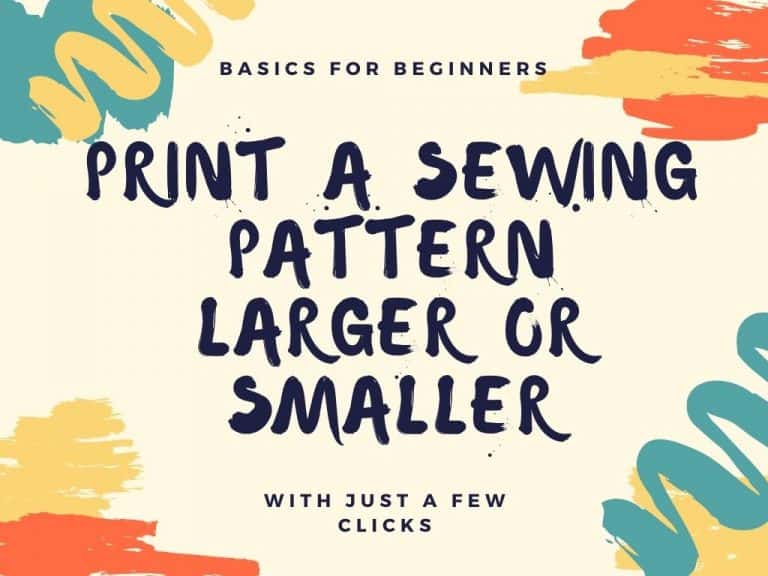A complete sewing glossary of terminology explained for beginners
I am so pleased to bring you this complete sewing dictionary. All of the commonly used sewing terms and abbreviations are described and defined here in this list so you’ll always know where to turn if you come across a word or phrase you’ve not heard in your sewing journey before.
There is nothing more frustrating than coming across an instruction in a sewing pattern or project and having no idea what it means. That can stop you right in your tracks. If you are told to ‘drop your feed dogs’ and have no idea what a feed dog looks like, where to find it or how to drop it, well, you’ll be stuck on that step until you can find help.

There are also some differences in terms and meanings depending on where you live. Did you know a muslin is called a toile in the UK? And that basting is also called tacking in British English? Tell a UK sewer to baste and they’ll think you mean to spoon juices over a turkey as it’s cooking! Although with the spread of the internet and digital patterns and sewing blogs becoming popular, it’s likely that sewers both sides of the ‘pond’ will understand all of these sewing terms today and use them interchangably.
Come across a sewing term that’s not included in this list? Please leave a comment at the bottom. Bonus points if you also include a definition as well!
Aa
- A-line – Dress or skirt resembling the shape of an A.
- Alter – To change the pattern or garment so that it fits the body and represents body measurements and proportions.
- Anchor stitches – These are machine stitches that are sewn with zero stitch length, to keep from pulling out. This term can also be used to refer to when you stitch backwards for a couple of stitches, to anchor it.
- Applique – From the French verb ‘appliquer’ which means to apply/put on this term is used to describe a sewing technique of applying a fabric design/shape on top of another layer of fabric and then fixed into place, either by sewing or using a fusible agent.
- Armscye – The armscye is the opening in the bodice to which the sleeve is attached.
Bb
- Backstitch – A backstitch is necessary to secure a line of stitches. Backstitching is overlapping stitches at both the beginning and end of a stitching line. This is done by sewing approx. 1-3 stitches by machine, reversing the direction of the feed dogs and stitching directly on top of the previously-made stitches. After backstitching, continue sewing the rest of the seam, and repeat the backstitching process at the end of the stitching line.
- Ballpoint needle – are sewing machine needles specially designed for sewing with knit fabrics. They have rounded tips, specially designed to slip in between fabric fibres and to prevent piercing them, which would damage knits.
- Bar tack – A short reinforcement of threads used on parts of a garment or project that are especially stressed, such as belt loops or buttonholes. Also known as a tack.
- Baste – Basting stitches are long stitches done by hand or machine that temporarily hold fabric in place before sewing. They are usually removed once the final seam is in place. Also called “tacking” in Britain.
- Bias – True bias is a cut made on an angle, 45 degrees to the selvage. This direction allows for the most stretch. Bias refers to any line diagonal to the crosswise and lengthwise grains. Most bias pattern pieces are laid on the true bias; the grainline arrow and the pattern’s layout instructions will help you align your pattern pieces.
- Bias tape / bias binding – Bias tape or bias binding is a narrow strip of fabric, cut on the bias. The strip’s fibers, being at 45 degrees to the length of the strip, makes it stretchier as well as more fluid and more drapeable compared to a strip that is cut on grain. Many strips can be pieced together into a long “tape.” The tape’s width varies from about 1/2″ to about 3″ (10mm to 75mm) depending on applications. Bias tape is used in making piping, binding seams, finishing raw edges, etc. It is often used on the edges of quilts, placemats, and bibs, around armhole and neckline edges instead of a facing, and as a simple strap or tie for casual bags or clothing. While bias tape can be handmade, it is also available in pre-packaged lengths (although usually only in basic colors).
- Binding – Binding is used as both a noun and a verb to refer to finishing a seam, edge or hem of a garment, usually by rolling or pressing then stitching on an edging or trim.
- Birds nest – The tangled loops of stitching on the bobbin side of the fabric that result from improper tension when machine sewing.
- Blanket stitch – A hand stitch used for finishing a fabric edge.
- Blind hemming – This is when you turn up the edge of a garment and stitch so they are hidden from the surface/outside of the garment.
- Bobbin – A plastic or metal cylinder which holds the bottom thread of a sewing machine. Thread is wound on the bobbin and this lower thread loops with the upper needle thread to form the stitches
- Bobbin thread -The thread that comes up from the bottom and meets the thread from the spool to form the stitch. Bobbins need to be wound up and inserted properly into a sewing machine.
- Bodice – Then part of a garment which reaches from the shoulder to the waist. It can be attached to the skirt piece to form a dress.
- BOM – Block of the Month. A quilting sew along where participants complete one quilt block per month and sew them all together at the end to make a finished quilt.
- Buttonhole – A sewn hole in the fabric made deliberately to allow buttons to pass through to fasten the item securely closed. Can be worked by hand or machine (with or without specialist foot).
Cc
- Casing – A casing is a fabric tunnel through which elastic or a drawstring can be threaded to pull in or draw up the fabric.
- Charm square/charm pack – Ready cut 5″ squares pieces of fabric used for patchwork.
- Clipping corners – The process of snipping the triangular piece of seam allowance off of the corner of a seam to prevent bulk in the corner when turned right side out.
- Crazy quilting – The art of using every last scrap of leftover fabric in a productive manner, totally disregard any “rules of patchworking and simply stitch and enjoy
- Crossgrain – The cross grain runs perpendicular to the selvage.
- Cutting line – On a pattern, this is the line you cut along. This is either the the outer, usually solid, line or the patterned line relevant to your size.
- Cutting mat – Used in conjunction with a rotary cutter this self-healing board is used for cutting fabic on, because it can self heal it is not left damaged or marked by the rotary cutter. They are often marked with measuring grids to help you cut your fabric to size.
Dd
- Dart – A dart is a common technique used for shaping garments. Darts are created by stitching out a wedge-shaped fold of fabric. They vary in width and length and can be tapered at one or both ends. They frequently appear around the bust and waist.
- Digital pattern/PDF pattern – a sewing pattern that can be downloaded from the internet and printed at home. Usually in PDF format.
- Double needle – 2 machine needles attached to a single shaft, that sews 2 parallel rows of stitches at once with 2 spools of thread and a single bobbin. Also called a twin needle.
- Drape – The fluid way that the fabric hangs in a garment.
- Drop the feed dogs – the feed dogs are the zagged metal bars under your sewing machine needle that help hold the fabric in place and keep the stitches even. Free machine embroidery is achieved by dropping the feed dogs away from the fabric, allowing the fabric to be moved freely in any direction. The machine will no longer regulate the stitch length for you, so you need to move the fabric carefully in order to achieve the length of stitches you require.
- Duck cloth -from the Dutch word doek meaning cloth. A very useful, high quality, utility fabric, similar in feel and weight to canvas, available in different weights.
Ee
- Ease – The allowance of space in a pattern for fit, comfort and style, over exact body measurements.
- Edgestitch – To edgestitch, add a second row of stitches very close to the seam line on the right side of the fabric. This is usually sewn to keep pressed seams in place.
- Embroidery – an ancient variety of decorative needlework in which designs and pictures are created by stitching strands of some material on to a layer of another material.
- Eyelet – may refer to a metal, plastic, or rubber ring that is inserted into a hole made through another material; in this case it is synonymous with grommett. They may be used to reinforce the hole, to shield something from the sharp edges of the hole, or both. An eyelet may also be the hole itself, held open with stitches.
Ff
- Face – The “front” of a piece of fabric having a distinct front and back; same as right side.
- Facing – fabric used to finish the raw edges of a garment such as at neckline and armhole. Shaped facings are cut to match the edge they will face, and bias facings are strips of fabric cut on the bias or cross-grain and shaped to fit edge.
- Fat quarter – a quarter of a yard of fabric, measuring 18×22″. Mainly used for patchwork but great for other craft projects.
- FBA – Full Bust Adjustment. An alternation made to a pattern to account for a larger cup size than the pattern was drafted for.
- Feed dogs – are the little jagged feet that sit under your presser foot. If you can lift and lower these on your machine you will be able to use your machine for free hand embroidery.
- Finger press -The heat and force of your fingertips can easily put a crease in the fabric without using an iron.
- Finish seams – There are many ways to finish a seam or raw edge to get a neat look and prevent fraying. For sturdy fabrics, just trim seams with pinking shears. For lighter fabrics, use a zigzag stitch along the seam. Other methods of finishing include turned-under seams, bound edges, and serged edges.
- Fold line – Many pattern pieces are placed on the fold of a piece of fabric to ensure you cut a symmetrical piece. Follow the cutting layout to see whether to fold the fabric right sides or wrong sides together then place the edge of the pattern pieces marked ‘cut on the fold’ right up to the fold of the fabric then pin and cut out.
- Foot pedal -The part of a sewing machine that controls the speed at which the needle enters the fabric. It is controlled by the foot of the machinist and usually attaches to the machine via a lead.
- Free motion quilting – The use of a darning, hopping or free motion foot, with the feed dogs lowered, so you can move the fabric freely under the needle and effectively “draw” on the fabric with the thread in whatever shape comes to mind.
- French seam -with wrong sides together stitch your seam, turn wrong sides out (i.e. right sides together), press (optional) and restitch the seam, using a slightly larger seam allowance. This results in a neat seam with no raw edges to finish.
- Frogging – The art of unpicking. Name attributed to the croaking sounds of frogs croaking ie rip-it, rip-it.
- Fusible fleece – An iron on interfacing made from soft, lightweight synthetic material. One side has an adhesive surface that when ironed bonds to other materials. Used to give volume and structure to projects such as bag making. It can be washed and tumbled dried.
- Fusible interfacing -Commonly referred to as simply “Fusible” it is an interfacing fabric with glue on one or both sides that is ironed onto either a lining, facing or body fabric to provide structure.
- Fussy cut – this term is used to describe a method of cutting shapes out of printed fabric which puts a motif or design in a particular place on your shape. For example, if you are working on a patchwork quilt made up of squares and you want a rose in the centre of each square you could use a clear plastic template to fussy cut your square, making sure that the rose is at the centre of the square before you mark and cut your fabric.
Gg
- Gather/gathering – Gathering stitches are used to sew a longer edge to a shorter edge, resulting in fullness. Use a long stitch length and stitch two or three rows parallel to each other. Leave long thread tails which can be pulled to adjust ease on the longer piece of fabric before you sew.
- Godet – A godet is a piece of fabric wider at the bottom than at the top, often a circular sector, inserted into a garment to add fullness for ease of movement or as a design feature. Usually found in sleeves and skirts, but also in very full bell-bottom trousers.
- Gore – A gore is a shaped segment, narrow at the top and wider at the base, extending from the waistline to the hem of a skirt. Flared skirts can be made of 2 or more gores. Four-. six-. and eight-gore skirts are common.
- Graded seam – Usually used in clothing. Seams need to be graded to reduce bulk when pressing the seam allowance in a single direction. After the seam is sewn, trim the seam allowance in half. Then, identify which side of the seam allowance will be laying against the body once it is pressed, and trim that side of the seam allowance in half.
- Grain – 1. The lengthwise and crosswise grain of fabric refer to the directions parallel to the warp and weft, respectively. 2. With the grain indicates parallel to the threads of a woven fabric, lengthwise or crosswise.3. Dyed in the grain refers to dyeing with kermes, a red insect dye.
- Grainline – The grainline runs parallel to the selvage. The long arrow symbol printed on a pattern corresponds to the location of the fabric’s grainline when laying out patterns.
- Gusset – A gusset is a triangular or square piece of fabric inserted into a seam to add breadth or reduce stress from tight-fitting clothing. Gussets were used at the shoulders, underarms, and hems of traditional shirts and chemises made of rectangular lengths of linen to shape the garments to the body.
Hh
- Hand – A term used to describe the feel and texture of a fabric. “This fabric has a nice hand to it.”
- Hem – 1. To hem a piece of cloth (in sewing), a garment worker folds up a cut edge, folds it up again, and then sews it down. The process of hemming thus completely encloses the cut edge in cloth, so that it cannot ravel.2. A hem is also the edge of cloth hemmed in this manner.
- Hump-jumper – a tool used to level the sewing machine presser foot when sewing thick layers. The hump jumper tool will assist in preventing skipped or mis-shaped stitches when sewing up or down hill, from thin to thicker layers.
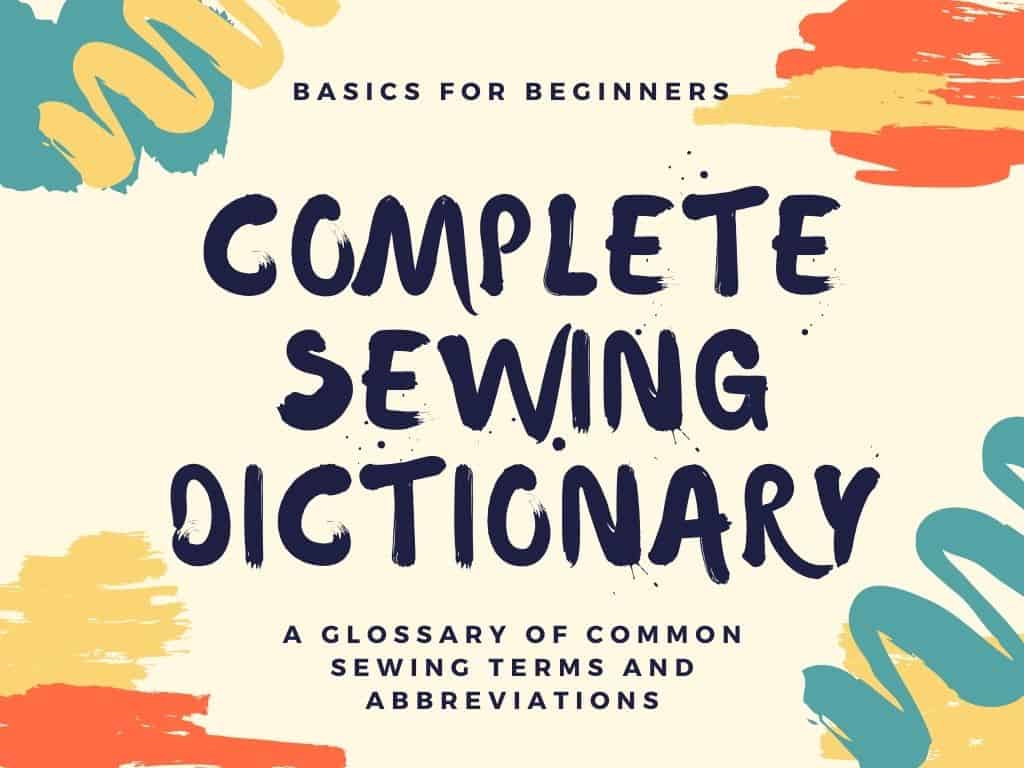
Download this article as a PDF
This article has been converted to a print-friendly PDF file to make downloading, saving and printing it easy. Any videos in the article still work. It’s available for optional purchase for your convenience.
Ii
- Interfacing – Interfacing is a common term for a variety of materials used on the unseen or “wrong” side of fabrics. Interfacings support the fashion fabric (“shell fabric”) of the garment and may be selected to change the hang of the fabric in some portions of the garment; for instance, a shirt collar has an interior stiffening from interfacing.
- Invisible zipper – These zips still have the 2 parallel rows of teeth but they are located at the back, behind the zip tape. If you choose an invisible zip that matches your fabrics colour then when inserted correctly only the slider will be visible and this is usually in the same colour, so will not stand out. This type of zip is usually found on formal garments, especially dresses.
Jj
- Jelly roll -created by Moda, Jelly Rolls are a pack of precuts which are 2.5″ x 44″. They can also be called Roll Ups.
- Jersey – Jersey is a stretchy knitted fabric.
Kk
- Knit fabric – Knit fabric is created from one continuous piece of yarn that is looped repeatedly. This looped structure gives knit fabrics a great deal of stretch. Knit fabrics will unravel but will not fray.
Ll
- Ladder stitch – used to close large openings or join two pattern pieces invisibly. Very useful for knitwear and rigid pieces of work. Often used in bag-making to close the gap in the bottom of the lining.
- Layer cake – a pack of pre-cut 10 inch squares used for patchwork, which can be cut again to create different shapes.
- Lining – 1. Lining is an inner layer of fabric, fur, or other material that provides a neat finish; conceals seam allowances, interfacing, and construction details; and allows a garment to slip on and off easily. 2. The process of inserting a lining layer.
- Lock stitch – This is the most usual and common type of stitching performed by sewing machines. A lock stitch is where two threads, one from the bobbin and one from the main thread are kept on their own side of the material, but literally ‘locked’ together each time the needle enters the fabric. The lockstitch is a secure stitch, that won’t come undone once the material is removed from the machine.
- Long arm quilting – Machine and frame used together to allow sandwiching of layers and free-motion quilting eg: for larger quilts.
Mm
- Muslin – Muslin is the American English term for a test garment, frequently made from this fabric. The equivalent British English term is toile.
Nn
- Nap – applies to fabrics that have a pile, such as velvet, velour, corduroy. It is important to ensure that these fabrics are cut out with the pile running in the same direction as fabric is lighter if you run your hand in one direction and darker if rubbed in the opposite direction.
- Neaten edges – The technique of finishing a raw edge in whatever manner you prefer; using pinking shears, a zig-zag stitch, an overlock stitch, or serging the edge. When a pattern asks you to neaten an edge, you choose the manner in which the edge is finished.
- Notch – Usually seen on clothing patterns with long seams. The notches on a pattern help align the pattern pieces when you sew them together. Another type of notch is one that is added when sewing the outside edge of a curved seam. These notches are added by cutting wedge shapes into the seam allowance at even intervals, being careful not to cut into the stitching.
- Notions – Notions are any small tools or accessories used in sewing. Think zips, thread, elastic, interfacing, buttons, hooks and eyes, ribbon and binding. Sometimes overlooked when purchasing the fabric, but all very essential for the end result to be perfect.
Oo
- OOP – Out Of Print. A pattern that has been discontinued.
- Overlocker / serger – a specialised sewing machine that trims and neatens the edge of fabric. Some models can also be used to make a decorative flatlock stitch used on hems and decorative seams.
Pp
- Patchwork – a form of needlework or craft that involves sewing together small pieces of fabric and stitching them together into a larger design, which is then usually quilted, or else tied together with pieces of yarn at regular intervals, a practice known as tying. Patchwork is traditionally ‘pieced’ by hand, but modern quiltmakers often use a sewing machine instead.
- Pattern – A set of sewing instructions sometimes with sized templates used to assemble a sewn item.
- PHD – Project Half Done. Similar to a WIP but more likely to refer to a project that has been abandoned unfinished.
- Pinking shears – Scissors that cut a zigzag edge thereby reducing the risk of fraying.
- Pincushion – a place to put pins and needles, available with wrist straps to make them accessible. Other pin cushions have materials to aid sharpening of pins and needle on use.
- Pintuck – A narrow, stitched fold of fabric. This style is usually seen in multiples and creates a stylish and smart finish.
- Piping – a type of trim or embellishment consisting of a strip of folded fabric inserted into a seam to define the edges or style lines of a garment or other textile object. Usually the fabric strip is cut on the bias or cross-grain, and often it is folded over a cord. It may be made from either self-fabric (the same fabric as the object to be ornamented) or contrasting fabric, or of leather
- Placket – 1. A placket is an opening in the upper part of trousers or skirts, or at the neck or sleeve of a garment Plackets allow clothing to be put on or removed easily. 2. A stomacher. Also spelled placard. 3. A slit to allow access to a hanging pocket, or a petticoat or skirt pocket.
- Pleat – A pleat is a type of fold formed by doubling fabric back upon itself and securing it in place. It is commonly used in clothing and upholstery to gather a wide piece of fabric to a narrower circumference. Pleats are categorized as pressed, that is, ironed or otherwise heat-set into a sharp crease, or unpressed, falling in soft rounded folds. Pleats may also be partially sewn flat and allowed to fall open below.
- Presser foot – A small piece of shaped metal near the needle on the sewing machine, that can be raised and lowered. It is the function that keeps your fabric in place while you sew. These feet can usually be changed to other feet for different sewing functions.
- Pressing – Using an iron in a downward motion only to press wrinkles from a fabric, press a seam open, create a crisp edge, or fold a crease in place. Different to ironing where the iron is moved across the fabric with pressure to remove creases and can stretch or distort the fabric.
- Pre-wash -After a fabric is purchased, it can be pre-washed. This is an important step if it is going to be made into a garment or project that will be machine washed and dried. This way the fabric will be pre-shrunk before constructing the garment. Typically, pre-washing of the fabric is done in the same manner that the garment is going to be washed when completed.
- Princess seam – A vertical seam line which gives shape to a garment in place of darts. Usually found on bodices, dresses, jackets, and blouses.
- QAYG – Quilt as you Go. The process of quilting a piece as you work on each block, rather than quilting the piece as a whole once piecing is finished.
- Quilting – a method of sewing or tying two layers of cloth with a layer of insulating batting in between.
Rr
- Raw edge – The raw edge is the unfinished, cut edge of the fabric.
- Right side / wrong side – The right side of the fabric will show on a finished garment or project; the wrong side will be on the inside. The patterned or printed side of a fabric is usually the right side with the plain side being the wrong side.
- Rotary cutter – A really useful tool for cutting material quickly and easily. It can cut through several layers of fabric at once and is best used in combination with a quilting ruler or other straight-edged implement.
- RST – Right Sides Together. Placing the face of the fabric pieces together.
- Ruching – A gathered overlay. The fabric is gathered on two parallel sides and stitched to an underlay, creating a shelf effect. It’s often done in sheers, like chiffon
- Ruffler -An attachment to your sewing machine that you fit instead of a foot. It can be used to gather/pleat the fabric as you sew. It differs from a small gathering foot as the gathers can be adjusted in length and frequency of tucks.
- Running stitch – an embroidery stitch that passes in and out of the fabric in a straight line. This stitch can be used to baste fabric pieces together.
Ss
- Satin stitch – a short zigzag stitch that forms a solid line, often used in applique.
- Scarf – the notch in the back of your sewing machine needle that allows the top thread to be picked up by the bobbin hook to complete a stitch.
- Scraps – all those left-over pieces of fabric that you keep for future projects.
- Seam – in sewing, is the line where two pieces of fabric are held together by thread.
- SA – Seam allowance – The seam allowance is the distance between the stitching line and the raw edge of a piece of fabric. Most commercial clothing sewing patterns have a 5/8″ seam allowance. Quilters often use a 1/4″ seam allowance.
- Seam ripper – A seam ripper is a small tool used for unpicking or cutting stitches.
- Selvage/Selvedge – Selvage is the self-finished edge of fabric. The selvages are located on either finished edge of fabric and are made while the fabric is being manufactured, usually on a loom.
- Sewing circle – A sewing circle is a group of people who meet and work on sewing projects together.
- Shirring – formed with multiple rows of gathering & is primarily a decorative way of controlling fullness. In contrast to gathering, in which fullness is controlled with a seam, the fullness in shirring is controlled over a comparatively wide span.
- Sloper – a base pattern used to develop other patterns. Often called a Block or Master Pattern. This pattern is highly developed and very accurate pattern that is designed to fit a specific set of measurements. This pattern is used in turn to create other more stylized patterns.
- Smocking – consists of fabric folds, decoratively stitched together at regular intervals to create a patterned effect. The folds may be pulled in when the stitching is done, or the fabric may be first gathered into folds & then smocked.
- Snips – small scissors designed to be used in one hand commonly used to cut threads as you remove a project from your sewing machine.
- Stash – Fabric which has been smuggled into the house without the knowledge (or consent) of your partner, and which is produced after a reasonable time has elapsed, when you can honestly say ‘I’ve had it for ages’
- Stay stitch – Staystitching is a straight stitch sewn through one layer of fabric. It’s most often used around a curve to prevent distortion, as it stabilizes a piece of fabric before it is sewn. This stitch is traditionally at a slightly smaller stitch length.
- Stitch in the ditch – term used to describe sewing along a seamline from the right side after the seam has been pressed open.
- Stitch length -The stitch length is determined by the movement of the feed dogs. It can be set so that the stitches are longer or shorter, depending on the project or fabric sewn.
- Surplice – a neckline formed by overlapping the left and right bodice pieces to form a “V”.
Tt
- Tailors chalk – A piece of chalk with a thin edge used to mark fabric.
- Tension – The amount of “pinching” done to your thread as it flows through your sewing machine. Thicker fabrics need a higher tension (a harder pinch so the thread doesn’t flow out too quickly), and thinner fabrics need less tension (a lesser pinch to let the thread out easily to prevent puckering).
- Test square – a square with measurements on a digital sewing pattern so the sewer can check the pattern has printed out at the correct scale.
- Thimble – a protective shield worn on the finger or thumb.
- Thread weight – a measurement of sewing thread so a sewer can compare the thickness of one thread with another and determine which thread to use for which project.
- Toile – the British English term for a test garment. The equivalent American English term is muslin.
- Topstitching – Topstitching is stitching on the outside of a garment that is parallel to, and usually 1/8th” to 1/4″ from the seam. To topstitch, sew through the fabric and seam allowance after pressing to help the seam lay flat. Topstitching is similar to edge stitching, but more noticeable, and can be used decoratively.
- Tracing wheel – used with dressmakers carbon to transfer information from the paper pattern to the fabric, such as positions and sizes of darts, circles, etc.
- Twill tape – a flat twill-woven ribbon of cotton, linen, polyester, or wool.
- Twin needle – An attachment for your sewing machine that produces parallel rows of decorative stitching in one easy step.
Uu
- UFO – Unfinished Object. Yet another unfinished sewing project.
- Understitch – stitching that helps seams lay flat and prevents facings and linings from rolling to the outside of the garment. Press the seam toward your facing, then stitch the facing to the seam, very close to the seam line.
Ww
- Wadding – refers to a fibrous material (such as cotton, wool or bamboo) used for filling items such as quilts, wall hangings and placemats. It comes in various thicknesses depending on the level of insulation required and can be purchased in a selection of pre-cut lengths or cut off the roll for a unique size. Also known as batting or filler.
- WIP – Work In Progress. An unfinished sewing project.
- WOF – Width of fabric. You will find this abbreviation in many quilting patterns.
- Woven fabric – Woven fabric is created by weaving multiple yarns across each other at right angles. These fabrics usually have no stretch along the lengthwise, little along the crossgrain, and the most stretch along the bias. Depending on the fiber content, some woven fabrics will have more stretch than others. Woven fabrics will unravel and raw edges should be finished.
- WST – Wrong Sides Together. Placing two pieces of fabric with the reverse of the fabric facing, as for sewing a French Seam for example.
Zz
- Zig-zag stitch -The stitch can be used for decorative purpose or for tidy up of seams; adjusting width and length allows you to achieve all sorts of effects; some modern machines allow patterns that involve zig-zag stitches.
- Zip/zipper – These are a closure method that uses 2 parallel rows of teeth that are attached to fabric tape. These are then stitched into an opening and closed using a slider which locks the teeth together. Standard zips are usually closed at the end of the tape – often in the form of a staple holding the 2 fabric tapes together.
- Zipper foot – An attachment for a sewing machine that is designed for installing zippers.

